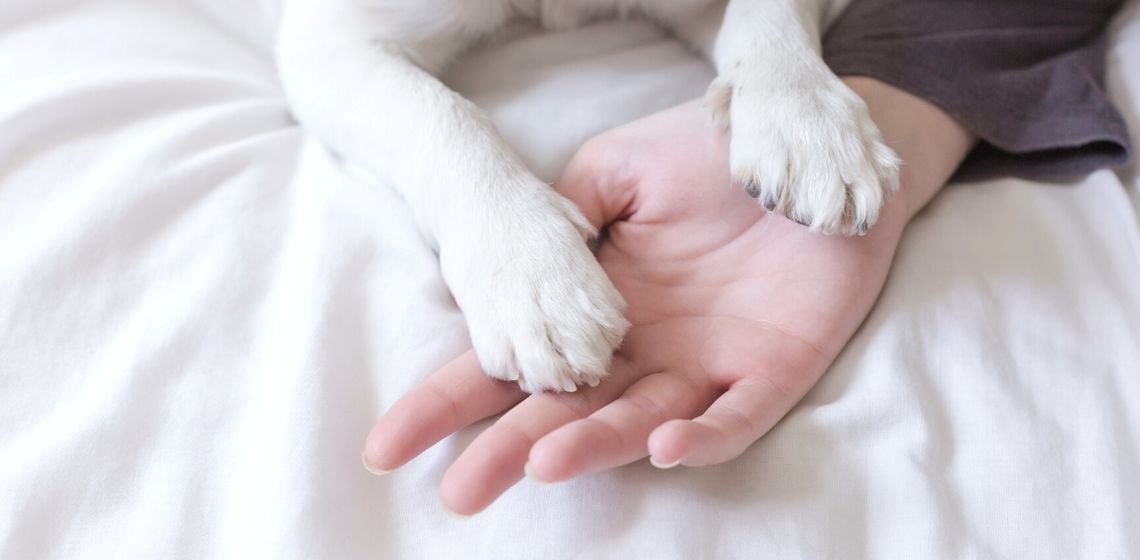Table of Contents
Recognizing the signs of a paw injury and understanding when you need to take your dog to the vet for a paw injury is valuable knowledge for all pet parents. Additionally, there are many steps pet parents can take to help prevent paw injuries.
Anatomy of Dog Paws
Dogs have four main toes that support their weight on their front and back feet. Each toe has a nail and its own pad called the digital pad. Behind the digital pad is another, larger, heart-shaped paw pad called the metacarpal pad. There is also thinner webbed skin in between the paw pads.
Most dogs have an additional nail higher up and on the inside of their front and back legs, commonly called the “dew claw.” Further up the leg, higher than the dew claw, is an additional paw pad called the “carpal pad.”
Paw pads are made of fat covered by very thick skin. The paw pads of dogs with more active lifestyles are usually harder and more calloused than dogs who walk or run on harder surfaces less frequently.
Signs Your Dog May Have a Paw Injury
The usual signs of various paw injuries include:
- Limping
- Blood from a nail, paw pad, or somewhere else on the foot
- Swelling of a toe or somewhere else on the foot
- A dangling nail or a “crooked” looking nail
- Obsessive licking or chewing at the paw
- Cracked, red, or blistered paw pads
- Your dog acting resistant or aggressive when you get near or touch their foot
The Most Common Paw Injuries in Dogs
Laceration
Lacerations, meaning cuts or tears, commonly occur on the paw pads or webbed skin between the toes. Lacerations can be very small or large, depending on how your dog cut their foot. Lacerations usually cause significant bleeding, and large tears are very uncomfortable. Most of these injuries are treated by thoroughly cleaning the cut, placing stitches or staples to encourage the skin to heal, and bandages to keep the wound covered and clean.
If you suspect your dog has a paw laceration, you can stop the bleeding by applying pressure with a clean towel or gauze before promptly taking them to a veterinarian for wound care.
Embedded Foreign Object
Dogs can step on sharp objects that become stuck in their paws. Any object can become embedded in a dog’s paws, but it most commonly occurs with thorns, burrs, wood splinters, or glass. Dogs with foreign objects stuck in their paws will usually obsessively lick at the spot, and the paw usually becomes tender and warm to the touch.
If you suspect your dog has something stuck in their paw, let your veterinarian remove it. Your veterinarian may also recommend X-rays before and after removing the object. Most dogs also receive a course of antibiotics to help treat and prevent infection from a foreign object stuck in the paw.
Broken Nails
Broken or twisted nails occur commonly in dogs, especially when their nails are long. Broken nails are painful and usually cause swelling and inflammation at the base of the nail (the area where the nail connects to the skin). Nails can get stuck in carpet, grass or weeds while running around outside, or even twisted when jumping off the couch or bed.
Seeing a veterinarian for a broken or twisted nail is usually recommended because the broken nail needs to be removed. If the nail is broken but not removed, it can cause prolonged pain and irritation to your dog. Additionally, many dogs with broken nails are prescribed antibiotics to prevent infection since the nail “quick” (the part inside the dog nail that contains a blood vessel and a nerve) is exposed and susceptible to infection.
Broken nails usually take a couple of months to grow back.
Paw Pad Abrasions, Cracks, and Burns
Paw pads are very tough skin, but they can become sore or even burned by walking around for long periods of time on hot surfaces, such as hot pavement. Dogs who run or walk long distances on hard surfaces can also develop sore and painful paws. Chemical burns to paw pads can also occur from harmful chemicals such as ice melt in the winter. Sore or burned paws are usually quite painful. Dogs will usually lick their feet to soothe the pain and are typically hesitant to walk around. Covering or bandaging the feet with supervision by your veterinarian and applying a soothing paw balm are usually needed to encourage healing. Healing may take several weeks, depending on the severity of the injury.
Some auto-immune diseases can lead to cracked and dry paws (hyperkeratosis, pemphigus). Initially, these symptoms may be mistaken for a paw injury because symptoms are similar, but they do not improve with bandaging or paw balm. Treatment may require long-term antibiotics or steroids.
Allergies and Growths on the Paw
While allergies and growths are not injuries, they are common reasons for dogs licking their feet or even limping. Allergies are the most common reason for dogs licking their feet. Bacterial and yeast infections on the skin in between the paw pads commonly occur with dog allergies. Treatment is varied and includes oral medications, topical sprays, or ointment.
Growths can occur anywhere on a dog’s body, including their paws. If you notice a growth on your dog’s paw, it needs to be assessed by a veterinarian to determine if it is benign or malignant. Surgery may be necessary to remove some growths.
Preventing Paw Injuries in Dogs
Paw injuries are not always preventable, but you can take steps to decrease the chance of your dog injuring their paw.
- Keep your dog’s nails trimmed. Long nails are more likely to get caught in something and twist and break. Most dogs need regular nail trimming every couple of months. Nail trims can be done at home, with a groomer, or at your veterinary hospital.
- Avoid walking your dog on hot surfaces. Hot pavement is a common culprit in paw sores and burns. A general rule of thumb is if the ground is too hot for you to touch for a couple of seconds, it is too hot for your dog to walk on. Choose a softer, cooler surface for walks in hot weather, like grass.
- Put booties on your dog. Putting booties on your dog’s feet when walking or hiking for a long time or on tough surfaces with rocks and plants can help prevent cuts and foreign objects from getting stuck in the paws. Not all dogs will tolerate wearing booties, but most can be trained to walk with them.
- Check your dog’s paws regularly. Doing paw checks at home to look at the nails, the paw pads, and between the toes after being outside can help identify any problems with your dog’s paws early on. Look for any broken nails, red or blistered paws, or objects stuck in the paw.

Ellen Russell, DVM, is a graduate of the Virginia-Maryland College of Veterinary Medicine and a practicing small animal veterinarian. She particularly enjoys geriatric animal care, feline medicine and veterinary public health.








